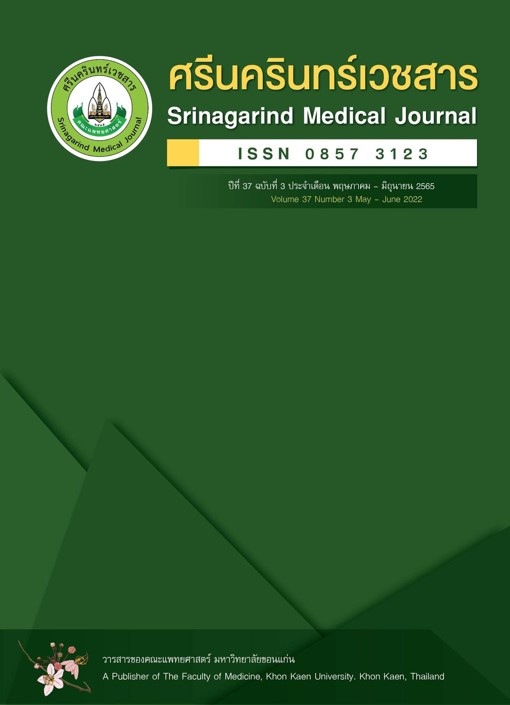Temporal Lung Changes in Chest X-Rays of COVID-19 Patients at Thabo Crown Prince Hospital
Abstract
การเปลี่ยนแปลงของปอดชั่วคราวที่พบในภาพรังสีทรวงอกของผู้ป่วยติดเชื้อโควิด-19 ที่โรงพยาบาลสมเด็จพระยุพราชท่าบ่อ
อภิวิชญ์ กุดแถลง
กลุ่มงานรังสีวิทยา โรงพยาบาลสมเด็จพระยุพราชท่าบ่อ จังหวัดหนองคาย
หลักการและวัตถุประสงค์: โรคติดเชื้อไวรัสโคโรนา 2019 (โควิด-19) ซึ่งเป็นการระบาดใหญ่ทั่วโลก ถือเป็นโรคติดต่อร้ายแรงที่ทำให้เกิดการเปลี่ยนแปลงทางพยาธิวิทยาของปอด ซึ่งอาจส่งผลให้เกิดภาวะปอดอักเสบรุนแรงจนถึงกลุ่มอาการหายใจลำบากเฉียบพลัน ในประเทศไทยการตรวจด้วยเครื่องเอกซเรย์เคลื่อนที่เป็นวิธีการที่ใช้กันแพร่หลายมากที่สุดในการประเมินและติดตามความผิดปกติของปอดในผู้ป่วยที่ติดเชื้อไวรัสโคโรนา 2019 การศึกษานี้มีจุดมุ่งหมายเพื่อศึกษาลักษณะภาพรังสีทรวงอกและการเปลี่ยนแปลงของปอดชั่วคราวที่พบในภาพรังสีทรวงอกของผู้ป่วยที่ติดเชื้อไวรัสโคโรนา 2019
วิธีการศึกษา: เป็นการศึกษาเชิงพรรณนาย้อนหลังของผู้ป่วยที่ติดเชื้อไวรัสโคโรนา 2019 ที่มีผลตรวจด้วยวิธี เรียลไทม์ พีซีอาร์ เป็นบวกที่เข้ารับการรักษาในโรงพยาบาลตั้งแต่วันที่ 1 กรกฎาคม ถึง 31 สิงหาคม พ.ศ. 2564 ได้มีการเก็บข้อมูลประชากรของผู้ป่วยและทบทวนผลการตรวจเอ็กซ์เรย์ทรวงอก โดยที่ภาพรังสีทรวงอกแต่ละภาพจะมีการให้คะแนนตามระดับความรุนแรงของรอยโรคในปอดในผู้ป่วยที่ติดเชื้อไวรัสโคโรนา 2019
ผลการศึกษา: ผู้ป่วยที่ติดเชื้อไวรัสโคโรนา 2019 ทั้งหมดจำนวน 487 ราย (เพศชายร้อยละ 48.3 และหญิงร้อยละ 51.7) อายุระหว่าง 3 เดือน ถึง 89 ปี (ค่าเฉลี่ย 36.22 ± 16.57 ปี) จำนวนภาพถ่ายรังสีทรวงอกผิดปกติที่นำมาวิเคราะห์จำนวน 335 รูปจากทั้งหมด 1,764 รูป (ร้อยละ 19) ความผิดปกติของภาพรังสีทรวงอกที่พบมากที่สุดคือความผิดปกติชนิดเห็นเป็นปื้นๆกระจายในส่วนรอบนอกของปอดส่วนล่างทั้งสองข้าง ความผิดปกติชนิดนี้สามารถพัฒนาเป็นแบบหนาทึบที่กระจายในปอดสองข้างทั้งส่วนกลางและส่วนล่างได้ในช่วงประมาณวันที่ 1-9 โดยพบได้บ่อยสุดประมาณวันที่ 1-4 หลังจากเข้ารับการรักษาในโรงพยาบาล (แบบปื้นๆ ร้อยละ 48, แบบหนาทึบ ร้อยละ 44) หลังจากนั้นความผิดปกติจะลดลงและเริ่มพบความผิดปกติแบบร่างแหประมาณวันที่ 10 หลังจากเข้ารับการรักษาในโรงพยาบาล ซึ่งเป็นลักษณะที่แสดงถึงการเริ่มระยะฟื้นฟูของโรค
สรุป: ภาพถ่ายรังสีทรวงอกมีประโยชน์ต่อการช่วยวินิจฉัย ประเมินและติดตามผู้ป่วยโรคปอดอักเสบจากการติดเชื้อไวรัสโคโรนา 2019 ระบบการให้คะแนนตามระดับความรุนแรงของรอยโรคในปอดเป็นวิธีที่ดีที่ใช้ในการพยากรณ์ความรุนแรงของโรคได้
Background and objective: Coronavirus disease 2019 (COVID-19), a novel worldwide pandemic, is a highly infectious disease, causing pathological lung changes that can result in severe pneumonia progressing to acute respiratory distress syndrome (ARDS). In Thailand, portable chest x-ray (CXR) machines are the most commonly used modality for assessment and follow-up of lung abnormalities in COVID-19 positive patients. This study aimed to describe CXR findings and temporal lung changes in COVID-19 patients.
Methods: A retrospective, descriptive study of patients with positive reverse transcription polymerase chain reaction (RT-PCR) tests for COVID-19 who were admitted from July 1 to August 31, 2021. Patients’ demographics and CXR findings were reviewed. The lung finding scores were summed to produce a total severity score (TSS).
Results: A total of 487 patients were included in the study: 48.3 % male and 51.7 % female. The ages of the patients ranged from three months to 89 years with a mean of 36.22 ± 16.57 years. A total of 1,764 chest x-rays were obtained of the 487 patients. Three hundred and thirty-five baseline CXRs and the serial CXRs of 92 patients with abnormalities were analyzed to examine temporal lung changes. The most common findings from CXRs were peripheral ground-glass opacities (GGO) affecting the lower lung zones. In the course of illness, the GGOs progressed into consolidations affecting the middle and lower lung lobes at around 1-9 days, peaking at day 1-4 after the initial CXR (GGOs 48%, consolidations 44%). The consolidations regressed and reticulations were developed after day 10 from the initial CXR, indicating a healing phase.
Conclusion: Chest x-rays are good for assessing and monitoring patients with COVID-19 pneumonia; the CXR scoring system provided a good method to predict disease severity.


